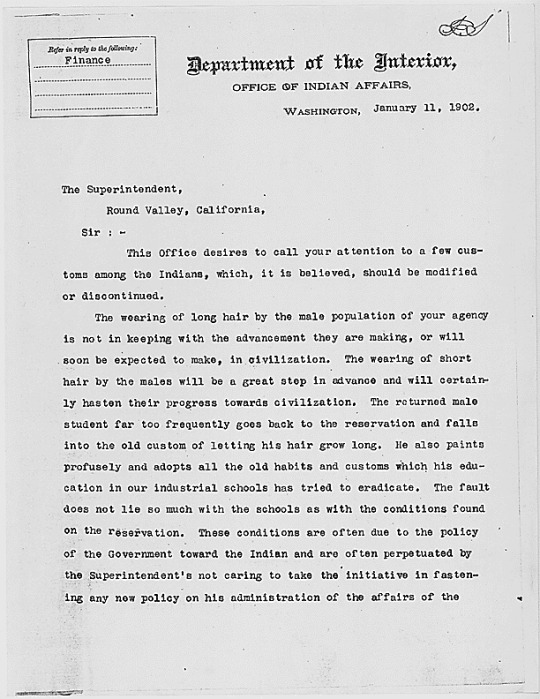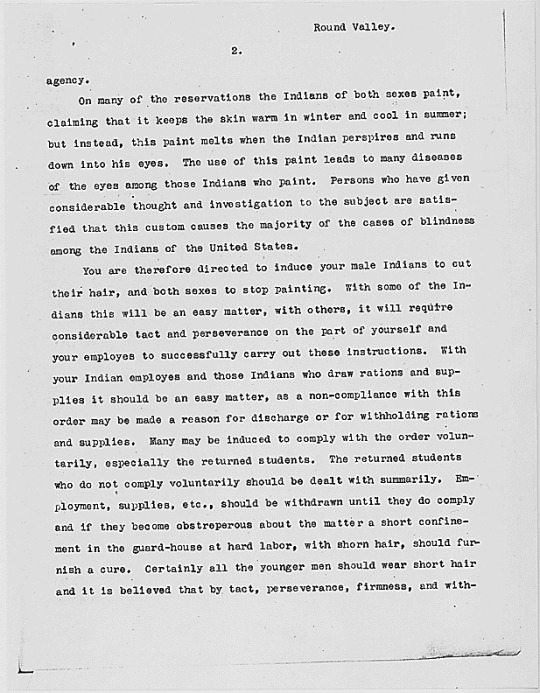#Nomlacki
Explore tagged Tumblr posts
Photo



“The wearing of long hair by the male[s] is not in keeping with the advancement they are making, or will soon be expected to make, in civilization. . . . a non-compliance with this order may be made a reason for discharge or for withholding rations and supplies.” 1/11/1902
File Unit: Book 1B, 8/24/1901 - 1/12/1903
Series: Letters to the Superintendent from the Commissioner of Indian Affairs, 1900 - 1914
Record Group 75: Records of the Bureau of Indian Affairs, 1793 - 1999
Transcription:
Department of the Interior
Office of Indian Affairs
Washington, January 11, 1902.
The Superintendent,
Round Valley, California,
Sir: -
This Office desires to call your attention to a few customs among the Indians, which, it is believed, should be modified or discontinued.
The wearing of long hair by the male population of your agency is not in keeping with the advancement they are making, or will soon be expected to make, in civilization. The wearing of short hair by the males will be a great step in advance and will certainly hasten their progress towards civilization. The returned male student far too frequently goes back to the reservation and falls into the old custom of letting his hair grow long. He also paints profusely and adopts all the old habits and customs which his education in our industrial schools has tried to eradicate. The fault does not lie so much with the schools as with the conditions found on the reservation. These conditions are often due to the policy of the Government toward the Indian and are often perpetuated by the Superintendent's not caring to take the initiative in fastening any new policy on his administration of the affairs of the
[page 2]
Round Valley.
2.
agency.
On many of the reservations the Indians of both sexes paint, claiming that it keeps the skin warm in winter and cool in summer; but instead, this paint melts when the Indian perspires and runs down into his eyes. The use of this paint leads to many diseases of the eyes among those Indians who paint. Persons who have given considerable thought and investigation to the subject are satisfied that this custom causes the majority of the cases of blindness among the Indians of the United States.
You are therefore directed to induce your male Indians to cut their hair, and both sexes to stop painting. With some of the Indians this will be an easy matter, with others, it will require considerable tact and perseverance on the part of yourself and your employes [sic] to successfully carry out these instructions. With your Indian employes [sic] and those Indians who draw rations and supplies it should be an easy matter, as a non-compliance with this order may be made a reason for discharge or for withholding rations and supplies. Many may be induced to comply with the order voluntarily, especially the returned students. The returned students who do not comply voluntarily should be dealt with summarily. Employment, supplies, etc., should be withdrawn until they do comply and if they become obstreperous about the matter a short confinement in the guard-house at hard labor, with shorn hair, should furnish a cure. Certainly all the younger men should wear short hair and it is believed that by tact, perseverance, firmness, and with-
[page 3]
Round Valley.
3.
drawal of supplies the Agent can induce _all_ to comply with this order.
The wearing of citizens clothing, instead of the Indian costume and blanket, should be encouraged. Indian dances and so-called Indian feasts should be prohibited. In many cases these dances and feasts are simply subterfuges to cover degrading acts and to disguise immoral purposes. You are directed to use your best efforts in the suppression of these evils.
On or before June 30, 1902, you will report to this Office the progress you have made in carrying out the above orders and instructions.
Very respectfully,
W. S. Jones
Commissioner.
WL. (S)
#archivesgov#January 11#1902#Bureau of Indian Affairs#Round Valley#Round Valley Tribes#Yuki#Wailacki#Nomlacki#Littlelake#Pit River#Concow#Pomo#hair#Native American history#American Indian history#Indigenous American history#California
79 notes
·
View notes
Text
Women of Running Strong: Cheryl Tuttle

Cheryl Tuttle is principal at Round Valley Elementary/Middle School (“Home of the Mustangs and Colts”) in Covelo, California. She has also been the mentor for three Running Strong for American Indian Youth® Dreamstarters®-- Blaze Burrows (2016), Shayleena Britton (2017) and this year Lourdes Pedroza-Downey, all members of the Round Valley Indian Tribe.

In her message to students and parents on her school’s website, Cheryl writes that she and her staff “are honored to serve as educators in this beautiful valley for children we love and respect and feel blessed to serve.”
In addition to serving as principal at the elementary/middle school, Cheryl also teaches Wailaki language classes at Round Valley High School where she has inspired Blaze, Shayleena, Lourdes and many other students at the school to work to preserve their nearly-lost tribal language.
The Round Valley Native American Studies Program, their Dreamstarter mentor organization, has a very powerful mission statement: “Through teaching about traditional values,
Native American history, contemporary Native American issues, local culture and Native language, the Round Valley Unified School District’s Native American Studies Program will inspire a deeper understanding of ourselves and our Native communities, promoting self-growth and encouraging generosity through community service and education.”

The program serves an amazing 350 individuals with a full-time staff of only two and about a dozen volunteers. Numerous articles have been published about Cheryl’s innovative techniques in instilling a sense of cultural pride in hundreds, if not thousands, of her students over the years.
The Press Democrat of Santa Rosa, California, report in 2017 that the school’s Wailaki language project is the “brainchild” of Tuttle and teacher Rolinda Want, a Dreamstarter Teacher, who a few years earlier began talking about adding a Native American language course at Round Valley High.
However, when Cheryl and Rolinda decided they wanted to teach a local language, they had many to choose from; many different tribes were forced onto what is now known as the Round Valley Indian Reservation, historically the lands of the Yuki Tribe. Many families of all those tribes – including Yuki, Wailaki, Concow, Little Lake Pomo, Nomlacki and Pitt River Indians – have resided there for generations.
When Cheryl and Rolinda decided to teach a local language, “they had many to choose from,” the Press Democrat reported. “The original reservation was a babel of languages, each with distinct dialects. Many of the current residents claim relatives from multiple tribes.
But one thread seemed to be a connector – “Everyone is like Wailaki and something else,” Cheryl said.
However, as The Press Democrat reported, it would be no easy task resurrect the language. For one thing, it was never a written language, so they had zero original documents to refer to.
In addition, no audio recordings existed, and as far as they knew, there was no one who actually spoke more than a few words of Wailaki.
For help, they turned to an assistant professor in the University of California at Davis’ Native American Studies program who had experience in what is known as the Athabaskan language group, and, as luck would have it, they connected with a UC Berkley linguistics grad student (and native Hupa) who was doing her dissertation on Wailaki grammar.
Among the invaluable resources they came across was the work of Pliny Earle Goddard, who in the first decade of the 20th century transcribed 36 stories told to him by a Round Valley tribal member known as “Captain Jim.”
From those and other sources, they were able to piece together a solid core of Wailaki and the first year they taught the class in 2014-15, they learned along with the class and since then the database has grown and changed.
And where words don’t exist, they have been creative in devising Wailaki equivalents – such as “hand talk” for “phone.”
Cheryl has developed strong relationships with her Dreamstarter® mentees such as Blaze, a student in her Wailaki class whose Dreamstarter® project was to spread knowledge about how to play a traditional Wailaki stick game.
“Blaze and I get along well, know each other as teacher-student who want to make a difference in our Native communities,” Cheryl reported.

She noted the positive change in Blaze, who was only 16 when he received his $10,000 Dreamstarter® grant, saying “Blaze has grown up with this grant. He started out very shy and withdrawn. The Running Strong Dreamstarter® Academy in Washington, DC, really challenged him, but he met the challenge and came away a stronger public speaker and more confident.
“The community has welcomed the stick game, as evidenced through the invitations we receive from community organizations that want Blaze to put on trainings and games at their events,” she reported. “The males involved in the training love it. They find the sport to be fun, and love the opportunity to feel that their ‘maleness’ is accepted and honored.
“I am renewed in hopefulness and energy as a result of seeing Blaze’s dream become a reality in such a short period of time. As a member of a Native community, I’ve lived with disappointment and heartache all the time, but with this project, through the eyes and efforts of a youth, I can see that we don’t have to live in disappointment and heartache; instead, I can turn my energies towar our youth, listen to their dreams, help them realize their dreams, and see a brighter future.”
And, as a whole, Cheryl observed that the Dreamstarter® program benefited not just Blaze, and not just the school, but the entire community.
“The grant allowed our youth to shine and provided an opportunity to integrate Native culture within the school district. Implementing this program within the school district helped with public relations with tribal members that haven’t, in the past, seen.”
For Cheryl, who is Yurok and Karuk, the Wailaki classes are much more than a fun way to keep kids occupied, notes The Press Democrat.
“I think that the language is the mind of the people,” Cheryl is quoted as saying. “Inside of the language, even in the way things are spoken about, you know how people thought. How the ancestors thought about things, what was important to them.
“Their world view is wrapped up in language.”
0 notes